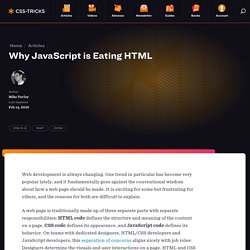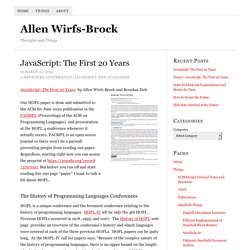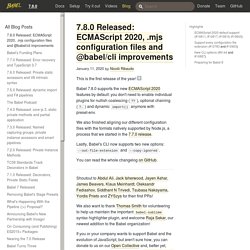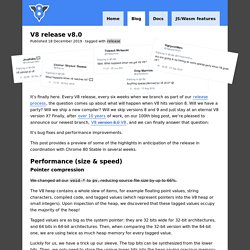Zoom
Trash

Why JavaScript is Eating HTML. Web development is always changing.

One trend in particular has become very popular lately, and it fundamentally goes against the conventional wisdom about how a web page should be made. It is exciting for some but frustrating for others, and the reasons for both are difficult to explain. A web page is traditionally made up of three separate parts with separate responsibilities: HTML code defines the structure and meaning of the content on a page, CSS code defines its appearance, and JavaScript code defines its behavior. On teams with dedicated designers, HTML/CSS developers and JavaScript developers, this separation of concerns aligns nicely with job roles: Designers determine the visuals and user interactions on a page, HTML and CSS developers reproduce those visuals in a web browser, and JavaScript developers add the user interaction to tie it all together and “make it work.”
People can work on one piece without getting involved with all three. Background: HTML, CSS, and JavaScript. JavaScript: The First 20 Years. JavaScript: The First 20 Years by Allen Wirfs-Brock and Brendan Eich Our HOPL paper is done and submitted to the ACM for June 2020 publication in the PACMPL (Proceedings of the ACM on Programming Languages) and presentation at the HOPL 4 conference whenever it actually occurs.

PACMPL is an open access journal so there won’t be a paywall preventing people from reading our paper. Regardless, starting right now you can access the preprint at But before you run off and start reading this 190 page “paper” I want to talk a bit about HOPL. The History of Programming Languages Conferences HOPL is a unique conference and the foremost conference relating to the history of programming languages. Version 9 of Angular Now Available — Project Ivy has arrived! The 9.0.0 release of Angular is here!

This is a major release that spans the entire platform, including the framework, Angular Material, and the CLI. This release switches applications to the Ivy compiler and runtime by default, and introduces improved ways of testing components. JavaScript End to End Testing Framework. JavaScript Libraries Are Almost Never Updated Once Installed. Cloudflare helps run CDNJS, a very popular way of including JavaScript and other frontend resources on web pages.

With the CDNJS team’s permission we collect anonymized and aggregated data from CDNJS requests which we use to understand how people build on the Internet. Our analysis today is focused on one question: once installed on a site, do JavaScript libraries ever get updated? Let’s consider jQuery, the most popular JavaScript library on Earth. This chart shows the number of requests made for a selected list of jQuery versions over the past 12 months: 7.8.0 Released: ECMAScript 2020, .mjs configuration files and @babel/cli improvements. This is the first release of the year!

🎉 Babel 7.8.0 supports the new ECMAScript 2020 features by default: you don't need to enable individual plugins for nullish coalescing (??) , optional chaining (?.) And dynamic import() anymore with preset-env. We also finished aligning our different configuration files with the formats natively supported by Node.js, a process that we started in the 7.7.0 release. New ES2018 Features Every JavaScript Developer Should Know.
Learn Development at Frontend Masters The ninth edition of the ECMAScript standard, officially known as ECMAScript 2018 (or ES2018 for short), was released in June 2018. Starting with ES2016, new versions of ECMAScript specifications are released yearly rather than every several years and add fewer features than major editions used to. The newest edition of the standard continues the yearly release cycle by adding four new RegExp features, rest/spread properties, asynchronous iteration, and Promise.prototype.finally. Additionally, ES2018 drops the syntax restriction of escape sequences from tagged templates. These new changes are explained in the subsections that follow. #The Rest/Spread Properties One of the most interesting features added to ES2015 was the spread operator.
The spread operator also comes in handy in situations where an array must be passed in as separate arguments to a function. ES2018 further expands this syntax by adding spread properties to object literals. Node.js: V8 release v8.0. It’s finally here.

Every V8 release, every six weeks when we branch as part of our release process, the question comes up about what will happen when V8 hits version 8. Will we have a party? Will we ship a new compiler? Will we skip versions 8 and 9 and just stay at an eternal V8 version X? Finally, after over 10 years of work, on our 100th blog post, we’re pleased to announce our newest branch, V8 version 8.0 V8, and we can finally answer that question: It’s bug fixes and performance improvements.
This post provides a preview of some of the highlights in anticipation of the release in coordination with Chrome 80 Stable in several weeks. Performance (size & speed) # Pointer compression # We changed all our void * to pv, reducing source file size by up to 66%. JavaScript, ES6, ES7, ES10 where are we? - Engineered @ Publicis Sapient - Medium. Faster JavaScript Apps with JSON.parse() – Bram.us. A performance trick that’s been doing rounds on Twitter, now available as a video: Because the JSON grammar is much simpler than JavaScript’s grammar, JSON can be parsed more efficiently than JavaScript.

This knowledge can be applied to improve start-up performance for web apps that ship large JSON-like configuration object literals (such as inline Redux stores). So instead of assigning a JS object to your store, assign the output of JSON.parse('{…}') to it. The Web Almanac by HTTP Archive. Part I Chapter 1 Introduction JavaScript is a scripting language that makes it possible to build interactive and complex experiences on the web.

Announcing TypeScript 3.7.